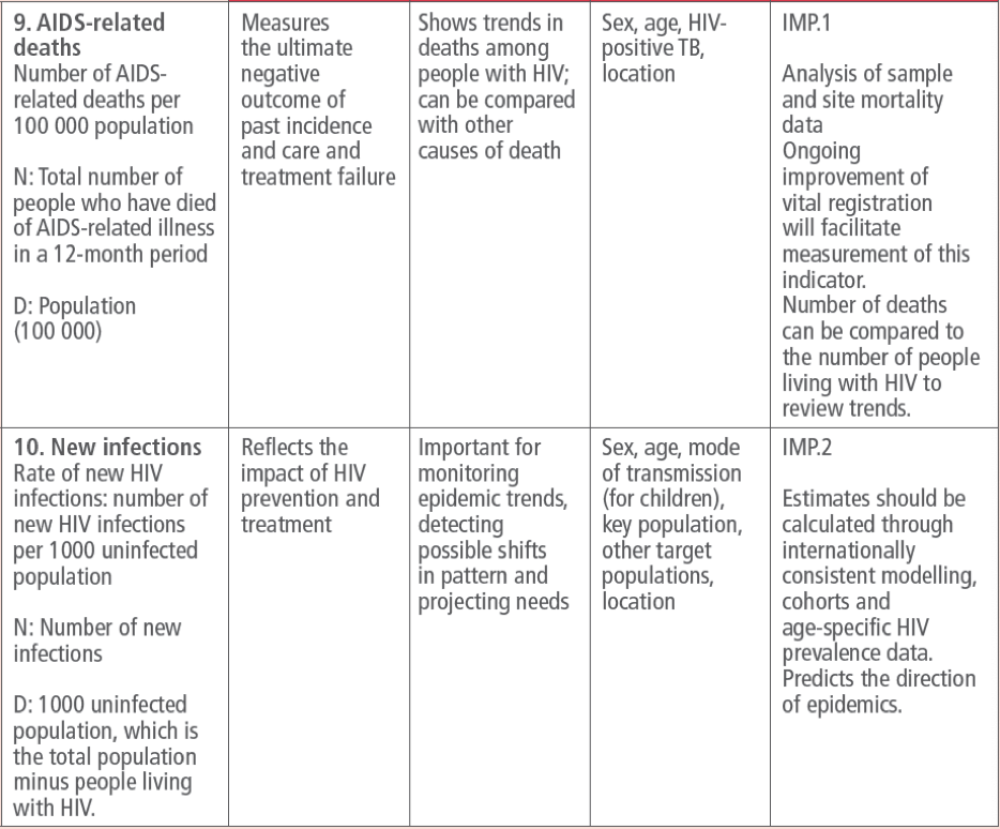global anti-HIV/AIDS efforts
US led
non US led (but partially US financed)
miami center for aids research (CFAR) international research
director - Dr. savita pahwa
slide 3
w/ american leadership, we are at unprecedented m,oment in global HIV/AIDS response. For 1st time in modern history, we have the opportunity to control a pandemic without a vaccine/cure. We have tools to do this, but the key will be a comprehensive implementation brought to scale to reach ppl already living with HIV and prevent new infections
15 yrs of leadership of US
PEPFAR
- widely regarded as 1 of most effective + efficient foreign assistance programs in history
- date driven, cost effective investments accelerating progress to controlling + ending HIV/AIDS pandemic as public health threat
- say saving lives without expanding budget
- focused on 3 ways to fight HIV
- mother/infant
- involuntary male cirucmcism program (VMMC) = lower chance of transmitting + getting HIV
- no only saving lives by treating HIV, but also stopping transmission before it happens thru 3 key prevention interventions
- pepfar is driving force to prevent mother-child transmission
- supported men/boys thru provisions of VMMC for 15.2 million
- pepfar designed DREAMS for women/girls (determined, resilient, empowered, AIDS free, mentored, and safe) publipc private partnership (PPP)
UNAIDS
joint united nations programme on HIV/AIDS
- joint venture of the UN family which brings together efforts + resources of 11 UN system organizations to unite the world against AIDS
- participating orgs that form UNAIDS
(unaids cosponsors)
- UNHCR (unations high commisioner for refugees)
- UNICEF (united nations children's fund)
- world bank
- UNESCO
- UN women
- UNDP
- UNFPA
- WHO
- world good programme
- UNODC
- ILO
- is a special arm devoted to HIV/AIDS
-
goals for UN:
- 2030: end AIDS as a public health threat
- 2020: achieve 90-90-90
- 90% of HIV+ individuals know their status
- 90% of THOSE go on treatment to prevent AIDS development/transmission
- 90% of THOSE ppl have viral suppressiom (not everyone taking drugs is virally suppressed, may be due to counterfeit drugs, low quality, etc.)
- 2025: achieve 95-95-95
WHO mission
seek to publish + disseminate scientifically rigorous public health information of international significance that enables policy-makers, researchers and practitioners to be more effective; it aims to improve health, particularly among disadvantaged populations
conduit for healthcare-related issues between donor and recipient nations
WHO cater to many diff types of ppl
- must be cognizant of donor/recipient nations
reproductive health in culture wars crossfire
in donald trump's 3rd day in office - ordered new abortion restrictions on US foreign aid
worldwide reaction against policy immidiate
1) recognizing that unsafe abortion is a major health risk for women in poor countries - estimated by WHO
2) to result in 47,000 deaths + millions of injuries annually
issues w/ donor countries, must keep them happy to continue operating (to continue their funding)
covid has skewed HIV data
...
slide 10
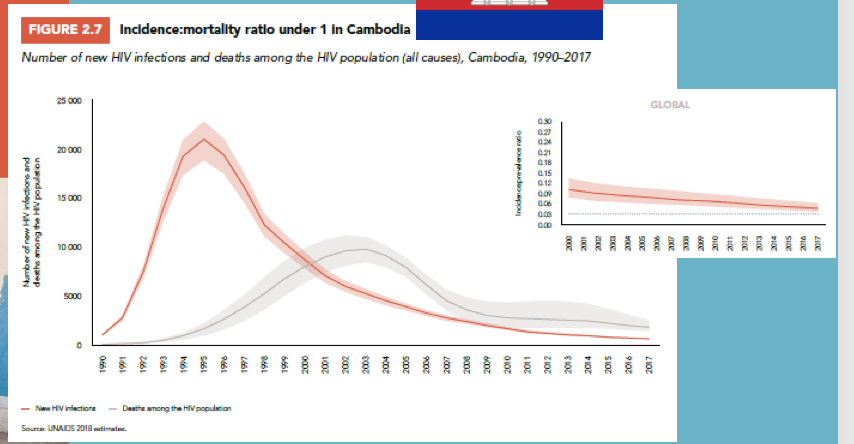
new HIV infection (red)
deaths (gray)
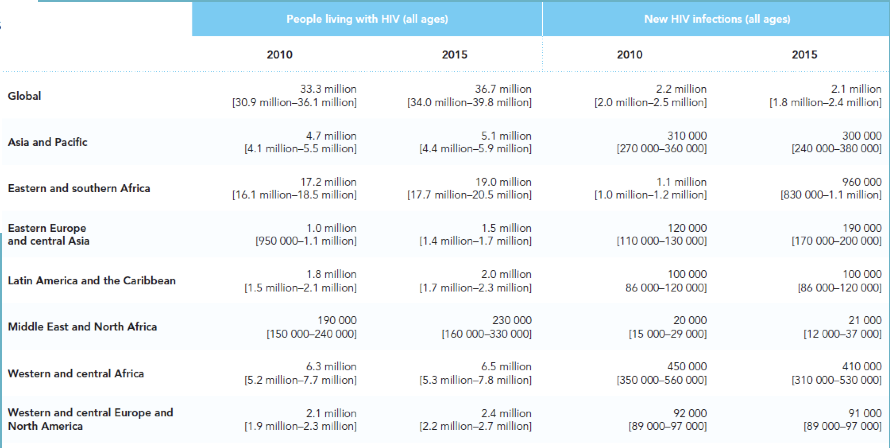
global HIV/AIDS picture (total infected + new infections)
...
global HIV/AIDS picture (drug coverage + deaths)
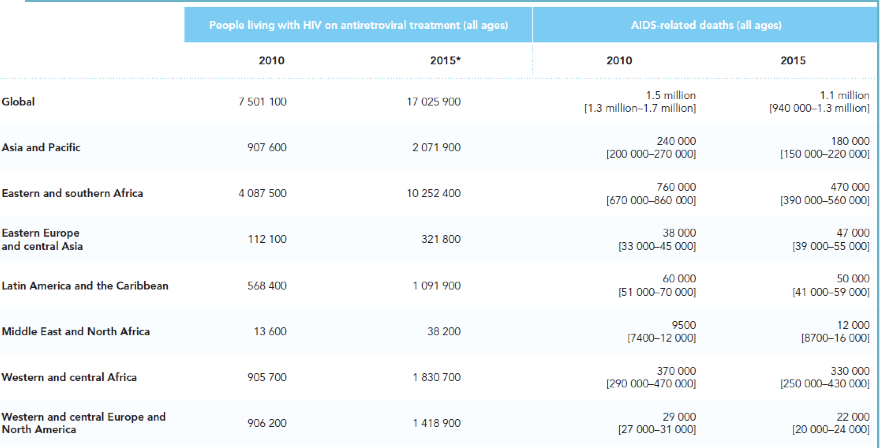
forest level vs tree level perspectives
- international community committed to ending AIDS epidemic as
public health threat by 2030
- ambitious target of 2030 agenda for sustainable development adopted by UN general assembly in septemebr 2015
- interim targets have been established for 2020
- ... etc. (was more)
continuum of HIV services and retention cascade
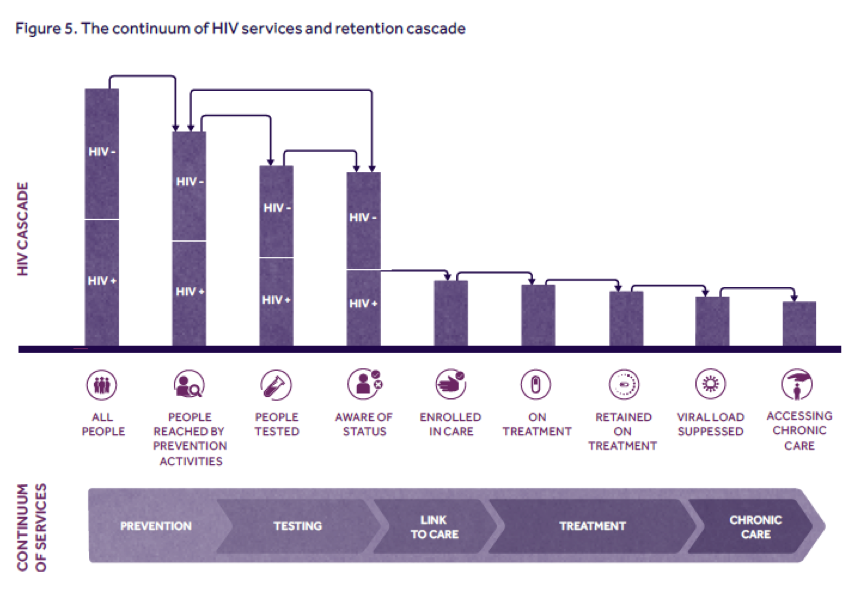
do you see viral load suppression in ppl on treatment + retained on treatment?
forest level vs tree level perspectives
get idea of what this publication is
mission state: seeks to publish and disseminate scientifically rigorous public health information of international significance that enables policy makers, researchers, and practitioners to be more effective; it aims to improve health, particularly among disadvantaged populations
focus on 1 country: south africa
research data from 1 country
1st 90: 86%
2nd 90: 65%
3rd 90: 81%
3/4 years ago in south africa (PLWH = ppl living with AIDS)
- 81% ppl on treatment were virally suppressed
- africa seems to be good at testing since high number of ppl know of their infection
reaching the "unreachable"
developing and testing "the treatment ambassador program" in south africa
her research in south africa
new HIV care cascade and opportunities to become lost to care after moving to treatment for all
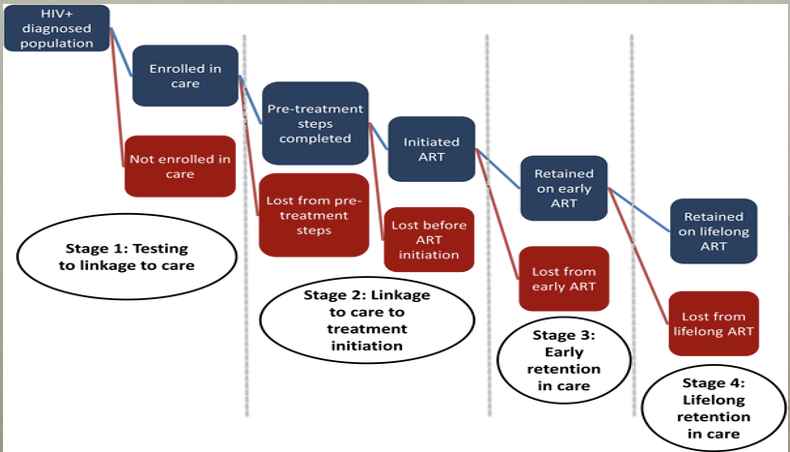
stage 3: how are we doing in early retention in care?
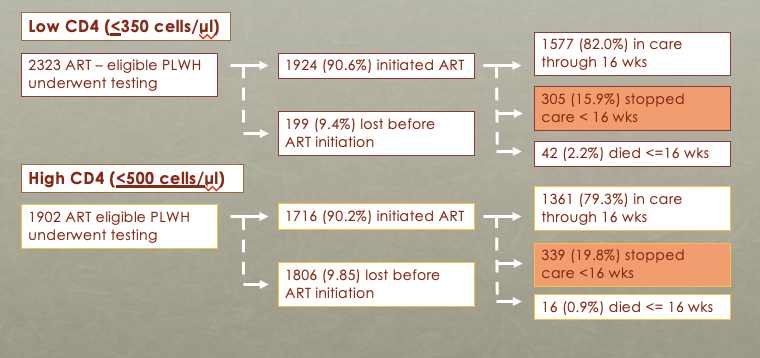
- study she was involved in, large population of HIV+ individuals
- become susceptible to opportunistic things w/ low
CD4
- 90.6% initiated therapy + 82% kept in care for 16 weeks
- tried to figure out how to get ppl on +
keep ppl on treatment
- developed TTI (next slide/card)
Using TTI to develop multi-level socio-behavioral intervention
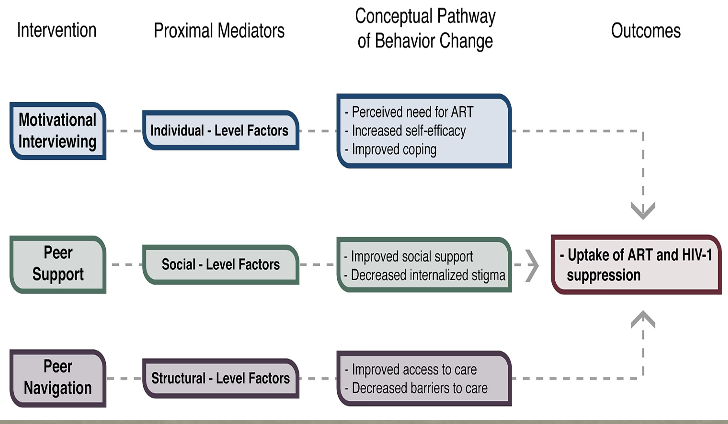
global anti-AIDS efforts
look at parts of book written + scan thru table of contents
use of antiretroviral drugs for treating and preventing HIV infection, WHO 2016
Table of Contents through ‘Definition of Key Terms’ (v-xv)
Recommendations (xxv-xliv)
4.1 Preparing people living with HIV for ART (p. 72)
5 Clinical Guidelines: Managing Common Coinfections and Comorbidities (pp. 192-195)
Table 7.1 Ten global monitoring indicators of the health sector response to HIV (pp. 314-317
10 global monitoring indicators on the health sector response to HIV
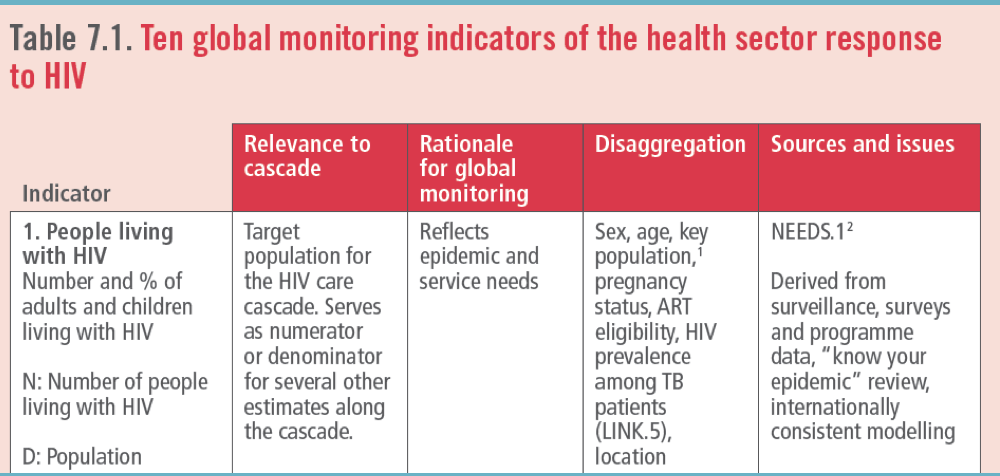
number of ppl w/ HIV / population
can be broken up into subpopulations, like pregnancies, etc.
- people living with HIV
2. domestic HIV financing
% contribution to HIV exposure
- what particular recipient country spending on anti HIV programs (HIV domestic = numerator)
- what is total expenditure? (domestic + foreign aid) (denominator)
% contributing of domestic public expenditure to total HIV expeniture
- important for sustainability of financing the response to HIV
- used to assess government commitment and ownership and to identify funding gaps
prevention strategies include (besides pep/prep)
- condom use
...
3. prevention by key populations
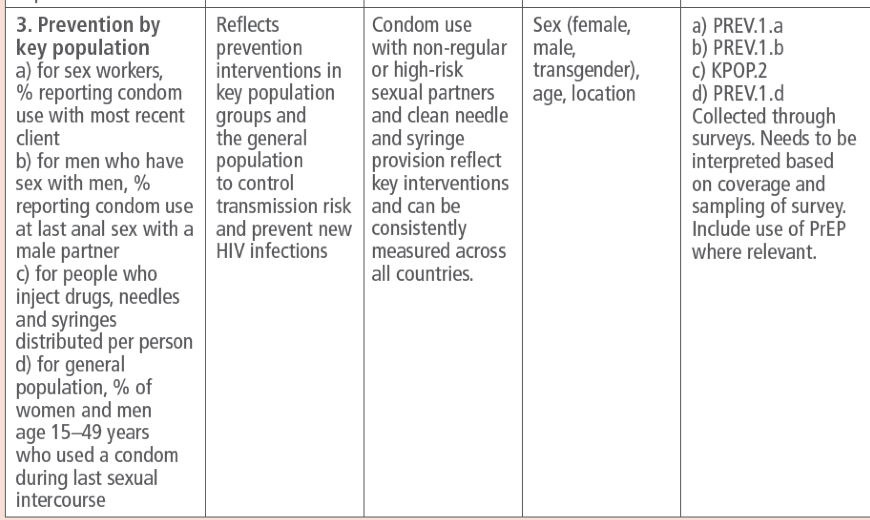
reflects prevention interventions in key population groups and general population to control transmission risk and prevent new HIV infections
condom use with non regular
prevention strategies include (besides pep/prep)
- condom use
indicator
a) for sex workers, % reporting condom use w/ most recent client
b) for men who have sex with men, % reporting condom use at last anal sex w/ male partner
c) for ppl who inject drugs, needles, syringes distributed per person
d) general population, % of women and men age 15-49 yrs who used a condom during last sexual intercourse
4. and 5.
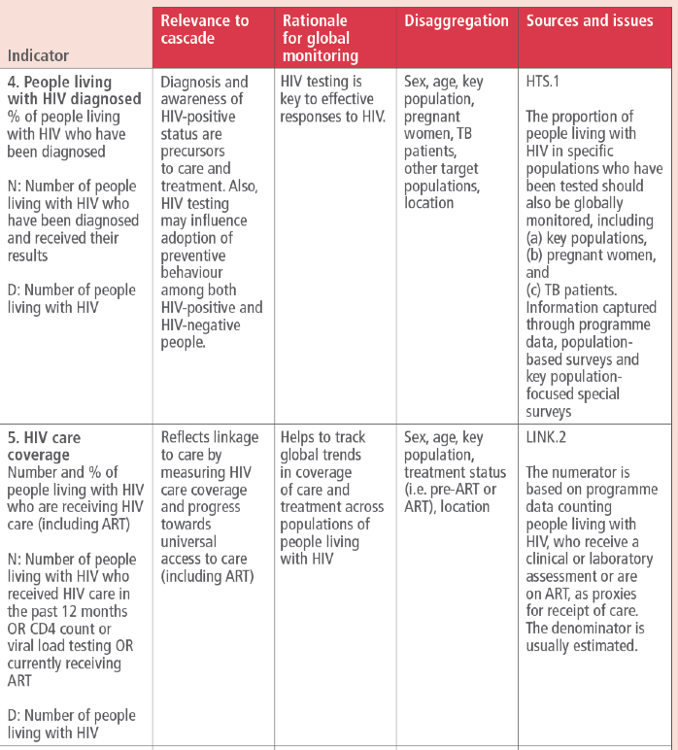
4. Ppl living w/ HIV diagnosed
(ppl w/ HIV diagnosed) / (# ppl with HIV)
- numerator known
- denominator = ESTIMATE
6.
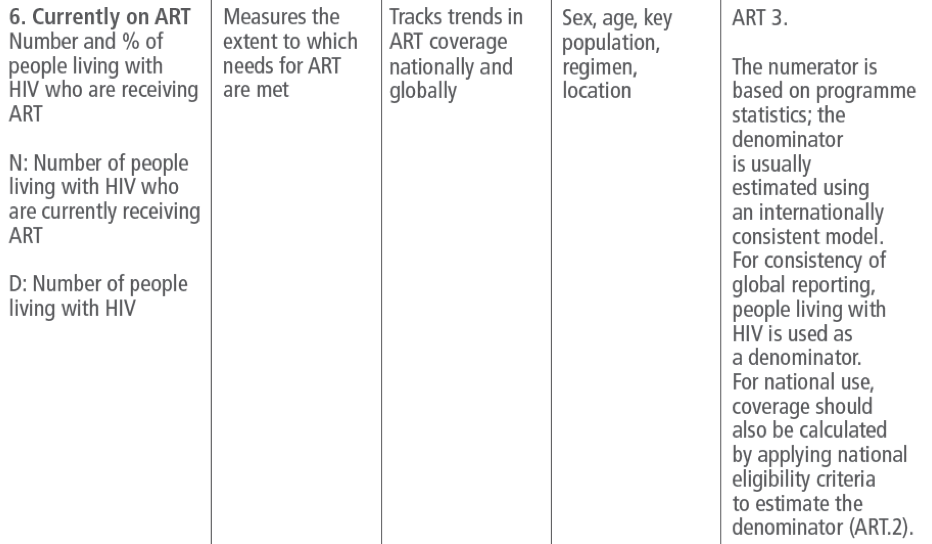
# ppl w/ HIV receiving ART
- portion of ppl w/ HIV who are on care
- denominator = estimate
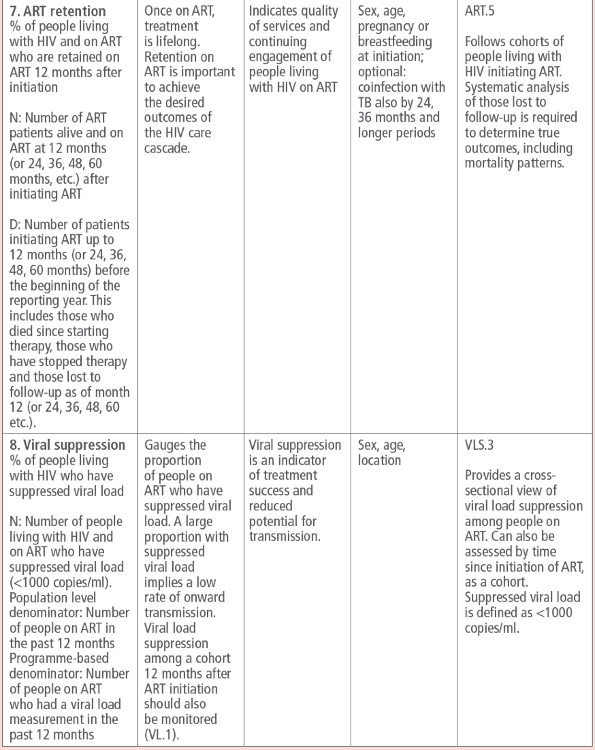
7. and 8.
7. Keeping ppl in care
- what % ppl in care for ___ (certain amount of time) / number pts initiate therapy who are lost
8. Viral suppression
- ppl lvijg w/ HIV on retrotherapy + suppressed viral loads / # ppl on viral load measurements in past 12 ,months
9. and 10.
